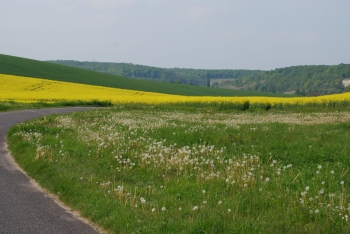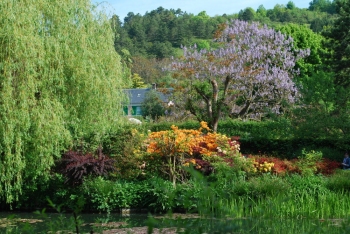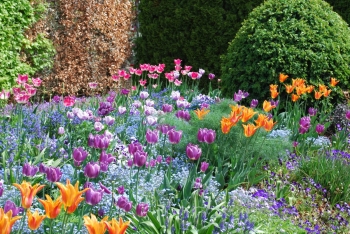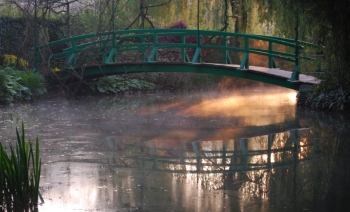Entries from May 2010
May 22, 2010
Every year in May, the yellow fields scattered all around in the countryside of Normandy intrigue visitors.
– What are they? they keep asking, struck by the vibrant color. No other crop induces so many questions.
– Rapeseed fields, I answer, trying to speak as distinctly as possible.
When visitors of Giverny come from a region of the world where rapeseed is unknown, they frown. They don’t want to believe that this is the real name of the plant. I must be wrong. They ask me to repeat.
I explain all what is done with rapeseed, oil, the green gasoline we call diester, and food for the cattle. I would so much prefer to answer, well, it is mustard for the french fries, you know! I long for next month, when the rapeseed will be blown, and the flax in blossom.
– What are the pale blue fields? people will ask, and they will be only too happy to see where their linen come from.
Posted in Flower No Comments »
May 20, 2010
The beautiful lavender blossom of the paulownia in Monet’s flower garden at Giverny harmonizes with the orange azaleas of the water garden, on the other side of the road.
The paulownia blooms exactly at the same time than the lavender wisterias gracing Monet’s Japanese footbridge.
Is it intended or not? What is a coincidence, and what is due to the choices of a clever gardener?
In Monet’s garden, I believe most of the meetings between plants aren’t accidental. Monet, as well as the present day head gardener, was very good at organising dates among the flowers.
Posted in Giverny, Monet's flower garden, Water-Garden 2 Comments »
May 7, 2010
American visitors to Giverny often ask to which agricultural zone Giverny belongs. A puzzling question indeed, as these zones aren’t commonly used in France!
Asking about the coldest temperature in Winter doesn’t help a lot, because the Frenchs count in Celsius, not in Farenheit.
I finally found the answer: Giverny is in zone 8.
During the coldest night of the last Winter, temperatures reached -13°C, that is to say 8°F. This is OK for many plants, trees and bushes, except the most fragile.
Some flowers even need frost to understand that it is Winter, and then Spring. If tulips, for instance, don’t get all the cold they need, they will sulk and refuse to bloom the next Spring!
Posted in Flower, Impressionism Museum No Comments »
May 1, 2010
Early in the morning, long before the first visitor arrives in Monet’s garden at Giverny, rays of orange sunshine stroke the Japanese bridge of the water garden, while a light mist raises from the pond.
Monet, who was an early bird, loved to get up before sunrise, in order not to miss a second of the dramatic show of light and water.
Posted in Giverny, Claude Monet, Water-Garden No Comments »



